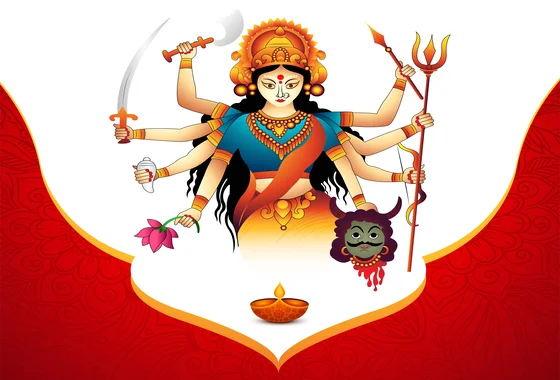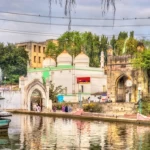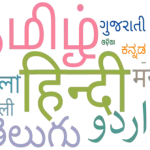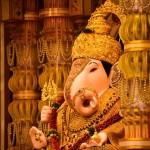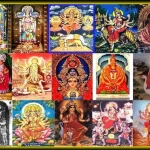Navratri: A vibrant and spiritual festival celebrated over nine nights, filled with dance, music, and devotion to goddesses.
Introduction
Navratri is one of the most vibrant and celebrated festivals in India, marking the triumph of good over evil. The name "Navratri" is derived from two Sanskrit words: "Nav" meaning nine and "Ratri" meaning nights. This nine-night festival is dedicated to the worship of the Hindu goddess Durga. It is celebrated with immense enthusiasm and fervor by millions of people across the country and the world. In this blog, we will explore Navratri's significance, customs, and spirit.
Navratri, a festival celebrated with unparalleled enthusiasm in India, is a nine-night-long ode to the divine feminine energy embodied by Goddess Durga. Each day of Navratri is associated with a specific color, and this vibrant spectrum of colors adds a unique and colorful dimension to the festivities. In this blog, we will delve into the significance of each day's color and how it reflects the multifaceted nature of this incredible celebration.
The Significance of Navratri
Navratri is celebrated to honor and seek the blessings of the goddess Durga, who is revered as the divine feminine force that symbolizes power, courage, and protection. The festival commemorates the nine different forms or avatars of Goddess Durga, with each day dedicated to a particular aspect of her.
Shailaputri (Day 1) Pratipada: On the inaugural day of Navratri, the divine goddess is revered in her form as the daughter of the mountains. She is often portrayed riding a bull while wielding a trident, symbolizing her unwavering strength and power. This day is characterized by the color grey, which embodies the serene anticipation before the fervor of the festival unfolds. Grey is a representation of her graceful presence and inner strength.
Brahmacharini (Day 2) Dwitiya: The second day of Navratri is dedicated to the worship of Goddess Brahmacharini, an embodiment of spirituality and unwavering devotion. She is often depicted carrying a rudraksha mala and a kamandalu. This day, marked by the color orange, is symbolic of her ascetic way of life and also represents the auspicious beginnings she blesses her devotees with.
Chandraghanta (Day 3) Tritiya: On the third day of Navratri, devotees pay homage to the formidable aspect of Durga, known as Chandraghanta. She is recognized by the crescent moon adorning her forehead, which gives her the name Chandraghanta. This day is a tribute to her fierce yet serene presence. The color white is associated with this day, symbolizing her purity and the profound peace she imparts. It also serves as a reminder of the significance of righteousness in one's life.
Kushmanda (Day 4) Chaturthi: Kushmanda, the revered goddess on this day, is hailed as the creator of the universe. She is often portrayed holding a rosary and a kamandalu. The color red, symbolizing love, passion, and power, is intricately linked with Kushmanda, representing her boundless energy and profound strength as she weaves the very fabric of the cosmos.
Skandamata (Day 5) Panchami: The fifth day of Navratri is dedicated to Skandamata, the maternal form of the revered Lord Skanda (Kartikeya), with her son cradled in her lap. Skandamata is venerated on this day, and the color royal blue is chosen to symbolize her divinity and the boundless expanse of the sky, reflecting her celestial grace and significance.
Katyayani (Day 6) Shashti: On the sixth day of Navratri, Katyayani, the sixth incarnation of Durga, is celebrated for her unparalleled energy and formidable power. Katyayani embodies courage and determination. The chosen color for this day, yellow, serves as a vivid representation of her valor and the radiant promise of a new day.
Kalratri (Day 7) Saptami: On the seventh day of Navratri, devotees pay homage to Kalaratri, the formidable aspect of Durga, whose darkness symbolizes the night and her role in annihilating evil. Kalaratri's intense and transformative energy is celebrated, and the color green is associated with this day, signifying her potent force and her connection to the environment.
Mahagauri (Day 8) Ashtami: The eighth day of Navratri is dedicated to Mahagauri, celebrated for her unparalleled beauty and immaculate purity. Mahagauri is often depicted adorned in pristine white attire, symbolizing her serene and unsullied nature. On this day, the specific shade of peacock green is chosen to represent her remarkable beauty and graceful demeanor.
Siddhidatri (Day 9) Navami: On the concluding day of Navratri, devotees honor Siddhidatri, the bestower of supernatural powers and blessings. This day holds special significance, and the color purple is chosen to symbolize the amalgamation of all the colors, marking the grand culmination of this vibrant and spiritually enriching festival.
Customs and Traditions
Fasting: Fasting is a common practice during Navratri, with many people observing fasts for the entire nine days. Some opt for a complete water and food fast, while others prefer consuming light meals, such as fruits, milk, and specific ingredients like sabudana.
Dandiya and Garba: The festival is also known for its colorful dance forms, including Garba and Dandiya Raas. People dress in traditional attire, gather in groups, and dance in circles to the beats of folk music.
Goddess Durga Pandals: Elaborate pandals (temporary shrines) are set up in various places, showcasing idols of Goddess Durga, attracting devotees for worship and darshan (viewing).
Singing Devotional Songs: Bhajans (devotional songs) are an integral part of Navratri celebrations. People sing hymns and bhajans dedicated to Goddess Durga.
Vijayadashami: The tenth day of Navratri, known as Vijayadashami or Dussehra, marks the triumph of good over evil. It is the day when Lord Rama defeated Ravana, symbolizing the victory of righteousness.
Spirit of Unity and Joy
Navratri is not just a religious festival but also a celebration of unity and joy. People from all walks of life come together to celebrate the nine nights with great fervor. It is a time when communities bond over dance, music, and prayers. The vibrant colors of traditional attire, the rhythmic beats of the dandiya sticks, and the fragrance of incense in the air all contribute to the festive spirit of Navratri.
In Conclusion
Navratri beckons individuals to submerge themselves in devout reverence, exult in the celebration of femininity, and delight in the enchanting rhythms of dance and music. This festival stands as a testament to the opulent blend of cultural and spiritual diversity found in India. Regardless of whether one is a devout believer or simply an admirer of Indian culture, Navratri offers a spectacle well worth experiencing, serving as a splendid showcase of tradition, unity, and the unwavering triumph of good over evil. Indeed, Navratri transcends being just a festival; it is a living embodiment of India's rich cultural heritage and the profound diversity of its religious tapestry. The colors affiliated with each day of Navratri infuse it with layers of significance, forging deep connections between devotees and the multifaceted essence of divine femininity. As people unite to commemorate these nine nights through dance, harmonious melodies, and heartfelt prayers, the vivid spectrum of colors weaves a compelling tableau of time-honored customs and the indomitable spirit that pulses through this vibrant celebration.


